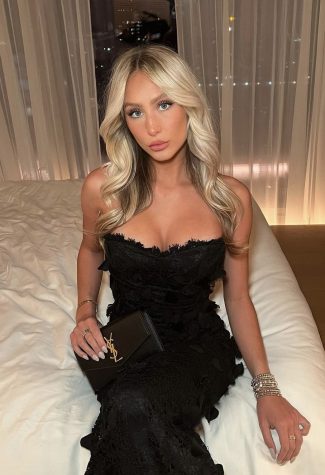The Alix Earle effect
Alix Earle, 22, is a senior at the University of Miami and one of the fastest-growing influencers on TikTok. Amassing over four million followers on the app in one month, she regularly posts lifestyle and get-ready-with-me (GRWM) beauty videos, a format which originally gained popularity on Youtube in the early 2000s. The structure of GRWM videos allow content creators like Earle to share their makeup routines, outfits and hairstyles while simultaneously discussing personal details about their life. From college to acne problems to romantic relationships, Earle touches on relatable topics that appeal to her audience of mostly young, impressionable girls.
In a response on Earle’s TikTok video explaining her acne problems and journey with the medication Accutane, user @zoemiyoko emotionally shared her gratitude about the transparency shown in the post. “I just wish there was someone like this around when I was growing up because I spent years hating myself for it,” she said. Her relatability and authenticity has been one of the reasons for her rise to fame, however, people have pointed to other possible causations for her popularity besides her content.
Looking into certain biases on TikTok’s algorithm, the engagement patterns from its users seem to be very significant. A.I. researcher Marc Faddoul described to Buzzfeed News how part of the algorithm includes collaborative filtering – a system that personalizes recommendations by showing videos liked by other users who engage in similar content. “Collaborative filtering may also reproduce whatever bias there is in people’s behavior.”
When users consistently celebrate specific creators, it garners them more influence and privileges that viewers might not have. Because Earle posts makeup content and conveniently fits the beauty standards seen on social media, her rise to fame can indicate the gravity of being conventionally attractive when creating a brand based on how you look.
“[Being attractive] is something that she spends a ton of money on, and most of the people that follow her can’t spend a ton of money on it,” said Co-Leader of Students for Women’s Equality And Rights (SWEAR) Micaela Winthrop ‘25. “It’s like some fantasy and that’s what she makes money off of.”
According to influencer coach Jessica Lillian, Earle can make up to 70 thousand dollars per brand partnership, depending on the reach of the campaign.

However, many people on the app have commented on the fact that Alix Earle is not the first woman to post this style of content. As a young white woman, she has profited off of beauty trends and gained a large following. According to Mckinsey and Co., Black Americans in 2021 contributed 11.1 percent to the US beauty market, but are three times more likely to be dissatisfied than non-Black consumers with their options for hair care, skin care, and makeup. Although Black people and other people of color formulate a huge part of the beauty industry, they almost never generate the same level of success or representation.
“There is a clear disparity between white people and people of color doing the same things,” said Winthrop. “Influencers of color that are trying to build brands have to market themselves a lot harder to get that same amount of fame and have to be even more beautiful to get the same media attention.”
Co-leader of the Women of Color affinity space (WOC) Zareen Abraham ‘25 spoke further on the difficulties women of color face when becoming an influencer in a predominantly white space.
“It’s difficult for people to see a woman of color so successful because … when they are [successful,] people think of it as a threat,” said Abraham.
Class of 2026 Dean Charisse Wu commented on how to overcome these challenges on a personal level. “I would say customize your feed and surround yourself with people, images, and media that are expanding your sense of how you can be out there in the world.”











